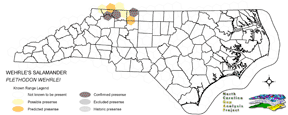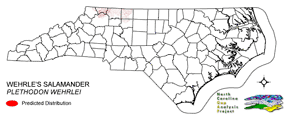
| Taxa: |
| Order: |
| Family: |
| Amphibia |
| Caudata |
| Plethodontidae |
| NatureServe Global Rank: |
| NatureServe State (NC) Rank: |
| G5 |
| S1 |
| Federal Status: |
| NC State Status: |
| --- |
| T |


| Land Unit |
| US Fish & Wildlife Service |
| US Forest Service |
| US National Park Service |
| US Department of Defense |
| NC State Parks |
| NC University System |
| NC Wildlife Res. Com. |
| NC Forest Service |
| NC Div. of Coastal Mgmt. |
| Local Governments |
| Non-Governmental Org. |
| Other Public Lands |
| Private Lands |
| GAP Status 1-2 |
| All Protected Lands |
| Statewide |
| Hectares |
| 0.00 |
| 0.00 |
| 0.00 |
| 1,325.25 |
| 1,484.91 |
| 38.25 |
| 480.24 |
| 0.00 |
| 0.00 |
| 0.00 |
| 39.69 |
| 0.00 |
| 36,543.87 |
| 3,366.54 |
| 3,366.54 |
| 39,912.21 |
| Acres |
| 0.00 |
| 0.00 |
| 0.00 |
| 3,274.76 |
| 3,669.29 |
| 94.52 |
| 1,186.70 |
| 0.00 |
| 0.00 |
| 0.00 |
| 98.08 |
| 0.00 |
| 90,301.85 |
| 8,318.90 |
| 8,318.90 |
| 98,625.20 |
| % of Dist. on |
| Prot. Lands |
| 0.0 % |
| 0.0 % |
| 0.0 % |
| 39.4 % |
| 44.1 % |
| 1.1 % |
| 14.3 % |
| 0.0 % |
| 0.0 % |
| 1.1 % |
| 1.1 % |
| 0.0 % |
| 0.0 % |
| 100.0 % |
| ----- |
| ----- |
| % of Dist. on |
| All Lands |
| 0.0 % |
| 0.0 % |
| 0.0 % |
| 3.3 % |
| 3.7 % |
| < 0.1 % |
| 1.2 % |
| 0.0 % |
| 0.0 % |
| 0.0 % |
| < 0.1 % |
| 0.0 % |
| 91.6 % |
| 8.4 % |
| ----- |
| ----- |
|
This salamander is known to occur in the state from specimens collected in Stokes County (Martof et al. 1980). It has a broader distribution in western Virginia. Wehrle's salamander is found in upland forests near the entrances of caves and among rock outcrops (Martof et al. 1980). It is perhaps most frequently found in rocky gorges that are covered with mesic hardwood forest (Redmond and Scott 1996). In Tennessee, two specimens were found on a shaded sandstone cliff face (Redmond and Scott 1996). NATURE SERVE GLOBAL HABITAT COMMENTS: Upland forests and woodlands (e.g., red spruce-yellow birch, mixed deciduous). Found in rock crevices, under rocks, logs, and leaves, and in twilight zone of caves (at lower elevations). Eggs are laid in damp logs, moss, cave crevices, and other protected sites. NATURE SERVE STATE HABITAT COMMENTS: Unknown. Generally under stones in mixed deciduous/conifer forests. |
| Code | Name | Description | NC Natural Heritage Program Equivalent |
| 230 | Piedmont Mesic Forest | American Beech - Red Oak - White Oak Forests. | Mesic Mixed Hardwood |
| 383 | Piedmont Mixed Successional Forest | Generally loblolly mixed with successional hardwoods. Sweetgum, tulip poplar and red maple are common co-dominants in these successional forests. | No equivalent |
| 522 | Northern Hardwoods | High Elevation forests including yellow birch, American beech, and yellow buckeye. Includes forests with Hemlock and Yellow Birch. | Northern Hardwoods Forest, Boulderfield Forest |
| 525 | Appalachian Oak Forest | A variety of oak forest types including Black, White, Scarlet Oaks in dry to mesic situations. Includes forests historically co-dominated by American Chestnut. | High Elevation Red Oak Forest, Montane White Oak Forest |
| 526 | Appalachian Cove Forest | Mixed Mesophytic forests of the mountains. Includes tuliptree, basswood, yellow buckeye and surgar maple. This class is mapped to include cove forests dominated or co-dominated by hemlock. | Rich Cove Forest, Acidic Cove Forest |
| 527 | Appalachian Hemlock | Upland hemlock forests of the moutains region. Vary from side slopes to steep slope positions. | Canada Hemlock Forest |
|
Redmond, W. H., and A. F. Scott. 1996. Atlas of amphibians in Tennessee. The Center for Field Biology, Austin Peay State University, Miscellaneous Publication Number 12. v + 94 pp.
Behler, J. L., and F. W. King. 1979. The Audubon Society field guide to North American reptiles and amphibians. Alfred A. Knopf, New York. 719 pp. Martof, B. S., W. M. Palmer, J. R. Bailey, and J. R. Harrison, III. 1980. Amphibians and reptiles of the Carolinas and Virginia. University of North Carolina Press, Chapel Hill, North Carolina. 264 pp. Green, N. B., and T. K. Pauley. 1987. Amphibians and reptiles in West Virginia. University of Pittsburg Press, Pittsburg, Pennsylvania. xi + 241 pp. Highton, R. 1987. PLETHODON WEHRLEI. Cat. Am. Amph. Rep. 402.1-402.3. |
For more information please contact them at:
NC-GAP Analysis Project
Dept. of Zoology, NCSU
Campus Box 7617
Raleigh, NC 27695-7617
(919) 513-2853
www.basic.ncsu.edu/ncgap